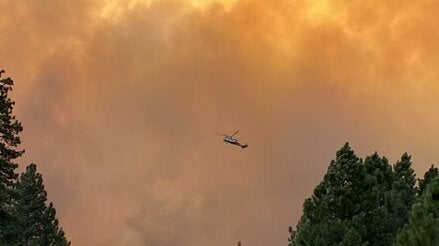The humongous Dixie fire in Northern California is still burning out of control as firefighters battle uncooperative weather conditions.
Related: Dixie fire spreading, now second biggest in California history
As of late Wednesday evening, the Dixie fire had burned more than 660,000 acres, about three times the size of Manhattan.
The wildfire led to a new round of evacuation orders as gusty winds helped spread the fire within about 8 miles of Susanville, California, which has an estimated population of 15,000. Flames and thick smoke were also approaching the nearby town of Janesville.
Late Tuesday, Pacific Gas & Electric said it began shutting off power to about 51,000 customers in 18 Northern California counties. The utility company announced that it enacted the Public Safety Power Shutoffs as a precaution against gusty winds damaging power lines and sparking more blazes. Many areas of the region have been bone-dry for at least a year, and wildfires have destroyed hundreds of homes, according to fire officials.
To the southeast of the Dixie fire, the Caldor fire exploded through Grizzly Flats, California, a town of about 1,200. Very few homes were left standing, and streets were littered with downed power lines and poles. A post office and elementary school were destroyed. This fire started Saturday and had already grown to 62,586 acres as of early Thursday morning with no containment.
Fire officials estimated that at least 50 homes had burned in the Caldor fire area, and two people were hospitalized with serious injuries. Gov. Gavin Newsom proclaimed a state of emergency in El Dorado County, where mandatory evacuations are underway.
It’s the second Northern California community destroyed by a blaze this month as thousands of residents left without assurances their homes would be there when they returned. The Dixie fire ravaged the gold rush town of Greenville on Aug. 4.
The Dixie Fire, the nation’s largest, has exploded since it began July 13. It’s also the largest single wildfire in state history — second largest counting the August complex, which included multiple fires that merged — and it’s the only California wildfire on record to burn across the Sierra Nevada.
It started in the range’s western foothills, spread up and over the crest and then descended into the eastern valleys. This is according to Thom Porter, director of the California Department of Forestry and Fire Protection.
“We don’t have any record of that happening before,” Porter said during a press conference Wednesday.
As of early Wednesday, 104 large wildfires were burning across the country, scorching 2.4 million acres in 12 states, 11 of them in the West.
The wildfires, in large part, have been fueled by high temperatures, strong winds and dry weather that left trees, brush and grasslands as flammable as tinder.
Numerous resources were put into Susanville, the seat of Lassen County and the largest city closest to the Dixie fire. Its residents were warned to be ready to evacuate, Mark Brunton, an operations section chief with the California Department of Forestry and Fire Protection, told USA Today.
Firefighters defended homes and pushed back the Dixie fire from the community of Janesville after spot fires took off Monday night. It was a fight to keep it back Tuesday as winds pushed the flames toward Susanville and Janesville.
Related: Western wildfires heating up jet fuel demand
Monday, crews were able to “herd the fire around the majority of the community,” Brunton said.
The fire destroyed some structures along the U.S. Highway 395 corridor and crossed the highway, spreading east. Portions of the highway are closed, except to crews working the fire. The winds will test the fire lines that firefighters have set so far.
Dixie fire public information officer Luis Jimenez said the wind could either help or hinder firefighting efforts, depending on which way it blows as the flames reach sagebrush-covered terrain. He recommended residents in the Susanville area be prepared to evacuate and consider leaving early.
“The best thing would be that if you’re in a warning or in an area that says it has a warning, have it planned,” Jimenez said. ”You don’t have to wait until you actually get to an order, you might as well be safe and get out now before things get chaotic.”
Across the state line in Nevada, school administrators delayed start times in the Reno-Sparks area because of dense smoke from the Dixie fire covering the region. Smoke plumes from the Caldor fire were also visible from northern Nevada.
More than two dozen large fires are burning in Montana, with more than 50 large fires in Idaho, Washington and Oregon combined, according to the National Interagency Fire Center.
Authorities ordered evacuations Tuesday for several remote communities in north-central Montana as strong winds propelled a large wildfire toward inhabited areas.
Related: How do wildfires get their names?
The mandatory evacuation covered Lodge Pole, a town of about 300 people on the Fort Belknap Indian Reservation, as well as the former mining town of Zortman, which has about two dozen people, according to a report from KOJM radio in Havre, Montana.
Click here for more FreightWaves articles by Nick Austin.
You might also like:
‘Full-court press’: Trucking industry relieved I-40 bridge repairs almost done
What are truckers’ favorite weather apps?
Hot Shots: Fire whirl, train derailments, huge hail and more










